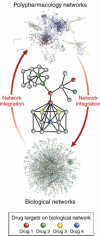Clinical Perspectives on Targeting Therapies for Personalized Medicine
- PMID: 26827603
- PMCID: PMC7102676
- DOI: 10.1016/bs.apcsb.2015.11.003
Clinical Perspectives on Targeting Therapies for Personalized Medicine
Abstract
Expected benefits from new technology include more efficient patient selection for clinical trials, more cost-effective treatment pathways for patients and health services and a more profitable accelerated approach for drug developers. Regulatory authorities expect the pharmaceutical and biotechnology industries to accelerate their development of companion diagnostics and companion therapeutics toward the goal of safer and more effective personalized medicine, and expect health services to fund and prescribers to adopt these new therapeutic technologies. This review discusses the importance of a range of new approaches to developing new and reprofiled medicines to treat common and serious diseases, and rare diseases: new network pharmacology approaches, adaptive trial designs with enriched populations more likely to respond safely to treatment, as assessed by companion diagnostics for response and toxicity risk and use of "real world" data. Case studies are described of single and multiple protein drug targets in several important therapeutic areas. These case studies also illustrate the value and complexity of use of selective biomarkers of clinical response and risk of adverse drug effects, either singly or in combination.
Keywords: Adaptive trial design; Biosimilars; Companion diagnostic; Companion therapeutic; Network pharmacology; Pharmacogenetics; Real world data; Transporters.
© 2016 Elsevier Inc. All rights reserved.
Figures



Similar articles
-
Using companion and coupled diagnostics within strategy to personalize targeted medicines.Per Med. 2012 Sep;9(7):751-761. doi: 10.2217/pme.12.86. Per Med. 2012. PMID: 29776269
-
Perspective for the development of companion diagnostics and regulatory landscape to encourage personalized medicine in Japan.Breast Cancer. 2016 Jan;23(1):19-23. doi: 10.1007/s12282-015-0586-y. Epub 2015 Jan 22. Breast Cancer. 2016. PMID: 25605056
-
Update on molecular companion diagnostics - a future in personalized medicine beyond Sanger sequencing.Expert Rev Mol Diagn. 2020 Jun;20(6):637-644. doi: 10.1080/14737159.2020.1743177. Epub 2020 Mar 19. Expert Rev Mol Diagn. 2020. PMID: 32167388 Review.
-
[Pharmacogenomics].Rinsho Byori. 2013 Nov;61(11):1018-25. Rinsho Byori. 2013. PMID: 24450107 Review. Japanese.
-
A Quantitative Assessment of Factors Affecting the Technological Development and Adoption of Companion Diagnostics.Front Genet. 2016 Jan 28;6:357. doi: 10.3389/fgene.2015.00357. eCollection 2015. Front Genet. 2016. PMID: 26858745 Free PMC article.
Cited by
-
Translating Knowledge Into Therapy for Acute Kidney Injury.Semin Nephrol. 2018 Jan;38(1):88-97. doi: 10.1016/j.semnephrol.2017.09.008. Semin Nephrol. 2018. PMID: 29291764 Free PMC article. Review.
-
Genetic variation of ABCB1 (rs1128503, rs1045642) and CYP2E1 rs3813867 with the duration of tuberculosis therapy: a pilot study among tuberculosis patients in Indonesia.BMC Res Notes. 2021 Jul 31;14(1):295. doi: 10.1186/s13104-021-05711-8. BMC Res Notes. 2021. PMID: 34332626 Free PMC article.
-
Compounded Nonsterile Preparations and FDA-Approved Commercially Available Liquid Products for Children: A North American Update.Pharmaceutics. 2022 May 10;14(5):1032. doi: 10.3390/pharmaceutics14051032. Pharmaceutics. 2022. PMID: 35631618 Free PMC article.
-
Paediatric medicine issues and gaps from healthcare workers point of view: survey results and a narrative review from the global accelerator for paediatric formulations project.Front Pharmacol. 2023 Jul 17;14:1200848. doi: 10.3389/fphar.2023.1200848. eCollection 2023. Front Pharmacol. 2023. PMID: 37529704 Free PMC article.
References
-
- 2015. ADAPT SMART: An enabling platform for the coordination of Medicines Adaptive Pathways to Patients (MAPPs) activities.http://www.adaptsmart.eu Accessed on 5th November, 2015)
-
- Avery P.J., Jorgensen A., Hamberg A.K., Wadelius M., Pirmohamed M., Kamali F. A proposal for an individualized pharmacogenetics-based warfarin initiation dose regimen for patients commencing anticoagulation therapy. Clinical Pharmacology and Therapeutics. 2011;90(5):701–706. doi: 10.1038/clpt.2011.186. - DOI - PubMed
Publication types
MeSH terms
LinkOut - more resources
Full Text Sources
Other Literature Sources

